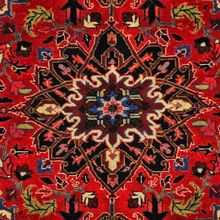Difference between revisions of "Sharabian Rug"
| Line 62: | Line 62: | ||
== Bibliography == | == Bibliography == | ||
* Abraham Levi Moheban, (2015), ''[[The Encyclopedia of Antique Carpets|The Encyclopedia of Antique Carpets: Twenty-Five Centuries of Weaving]]'', NewYork: Princeton Architectural Press. | * Abraham Levi Moheban, (2015), ''[[The Encyclopedia of Antique Carpets|The Encyclopedia of Antique Carpets: Twenty-Five Centuries of Weaving]]'', NewYork: Princeton Architectural Press. | ||
| − | [[Category: | + | [[Category:Persian Carpets]] |
[[fa:قالی_شربیان]] | [[fa:قالی_شربیان]] | ||
Revision as of 15:58, 10 March 2020
| Sharabian Rug | |
|---|---|
 Design of Sharbian Rug (Rugman) | |
| General information | |
| Name | Sharbian Rug |
| Original name | قالی شربیان |
| Alternative name(s) | Sharbian Carpet |
| Origin | |
| Category | Village |
| Technical information | |
| Common designs | Geometric, Medallion |
| Common colors | Black, Navy Blue, Red, Blue, Ivory |
| Dyeing method | Natural, Synthetic |
| Pile material | Wool |
| Foundation material | Cotton |
| Knot type | Symmetrical (Turkish) |
Sharbian rug originate from Sharbian, located in the Province of Azerbaijan in northwestern Iran close to Heriz. Sharbian enjoys the same rich history of Persian carpet making as its neighbor Heriz. Due in large part to their close proximity geographically, the similarities in both color and design in a Persian carpet from Sharbian and one from Heriz are quite striking. The art of Persian carpet weaving in Sharbian is much as it was thousands of years ago. The skilled artisans learn their craft from elder family members and it continues even today to be passed down through the generations. The looms used to create Sharbian rugs have not changed much in millennia and Turkish knots are still used.
History
Sharabian is a village located in the East Azerbaijan Province of northwestern Iran. It is situated close to the famous weaving village of Heriz. The population is Azeri tribe in origin and speaks a Turkic dialect. Sharabian carpet production started when the demand for Heriz carpets grew in the world marketplace during the turn of the twentieth century. Sharabian carpets ve Heriz design styles and are grouped under the Heriz carpet name.
After World War II, great quantities of Sharabians were produced for the domestic market and foreign export to the West.[1]
Materials
Foundation and Pile
The weavings have a cotton foundation and wool pile.[2]
Techniques and structures
Color and dyeing
The carpets generally have a brick-red or deep red background. Different shades of blue were used for the medallion and border. In addition to these colors, shades of red, ivory, green, rust, camel, coral, and brown are utilized for the design elements. Dark brown or black was incorporated for design outlines.[3]
Motifs and Designs
Sharabian background designs are nearly geometric or quasigeometric, featuring medallion or all-over styles. The motifs include palmettes, leaves, and vines, with primitive nomadic design elements.[4]
Weaving techniques
The Turkish (symmetric) knot is employed. Sharabians are durable as floor coverings because weavers tightly hammer the wefts during production. Sharabian sizes woven range from small mats to approximately fourteen feet by ten feet. A majority of carpets were made in standard dimensions of twelve feet by nine feet. Sharabian carpets are good in grade quality and are known to be durable.[5]
See also
References
Bibliography
- Abraham Levi Moheban, (2015), The Encyclopedia of Antique Carpets: Twenty-Five Centuries of Weaving, NewYork: Princeton Architectural Press.